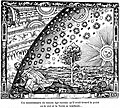Immaggine:FlammarionWoodcut.jpg
Câa

Dimenscioìn de st'anteprìmma chi: 660 × 600 pixel. Âtre resoluçioìn: 264 × 240 pixel | 528 × 480 pixel | 845 × 768 pixel | 1 127 × 1 024 pixel | 2 254 × 2 048 pixel | 2 934 × 2 666 pixel.
File òriginâle (2 934 × 2 666 pixel, dimensción do file: 9 MB, tîpo MIME: image/jpeg)
Cronologîa do file
Sciàcca in sce 'n grùppo dæta/ôa pe védde comm'o l'êa o file into moménto indicòu.
| Dæta/Ôa | Miniatûa | Dimenscioìn | Uténte | Coménti | |
|---|---|---|---|---|---|
| prezénte | 16:58, 3 lùg 2020 |  | 2 934 × 2 666 (9 MB) | Sette-quattro | High quality scan with the original caption, from http://urn.fi/URN:NBN:fi-fe2020052939747. Image has been deskewed. |
| 09:38, 19 zùg 2014 |  | 1 157 × 1 046 (703 KB) | DxhaFFer | There are two black-and-white versions of this image. One is supposed to have the caption underneath the engraving, the other one is supposed to be without it. This is the large version of the image with the caption taken from the page of the version w... | |
| 03:33, 14 màr 2006 |  | 1 162 × 973 (295 KB) | Brian Brondel | higher resolution | |
| 01:20, 9 zùg 2005 |  | 504 × 455 (118 KB) | Sparkit | Flammarion Woodcut. See wikipedia:Flammarion Woodcut {{PD-art}} |
Utilìzzo do file
Nisciùnn-a pàgina a contêgne sto file chi.
Utilìzzo globâle do file
Quésto file o l'é dêuviou da 'ste âtre wiki ascì:
- Dêuviòu inte pàgine de als.wikipedia.org chi de sótta:
- Dêuviòu inte pàgine de ar.wikipedia.org chi de sótta:
- Dêuviòu inte pàgine de ar.wikiversity.org chi de sótta:
- Dêuviòu inte pàgine de ast.wikipedia.org chi de sótta:
- Dêuviòu inte pàgine de bg.wikipedia.org chi de sótta:
- Dêuviòu inte pàgine de ca.wikipedia.org chi de sótta:
- Dêuviòu inte pàgine de de.wikipedia.org chi de sótta:
- Metaphysik
- Schamanismus
- Sternenhimmel
- Firmament
- Wikipedia:Wikipedianer/Soundtrack der Wikipedianer
- Portal:Philosophie/Ausgezeichnete Artikel
- Dualismus
- Wikipedia:Auskunft/Archiv/2006/Juni/3
- Portal:Philosophie/Lesenswerte Artikel
- Portal:Philosophie/Lesenswerte Artikel/Disziplinen und Begriffe
- Portal:Philosophie/Artikel der Woche/51
- Wikipedia:Café/Archiv 2010 Q1
- Diskussion:Weltbild
- Religionsanthropologie
- Benutzer:HerbertErwin/Metaphysik
- Benutzer:NeulichBeimOntologen
- Dêuviòu inte pàgine de en.wikipedia.org chi de sótta:
- Dêuviòu inte pàgine de en.wikibooks.org chi de sótta:
- Dêuviòu inte pàgine de en.wikisource.org chi de sótta:
- Dêuviòu inte pàgine de en.wikiversity.org chi de sótta:
- Dêuviòu inte pàgine de en.wiktionary.org chi de sótta:
- Dêuviòu inte pàgine de es.wikipedia.org chi de sótta:
- Dêuviòu inte pàgine de et.wikipedia.org chi de sótta:
- Dêuviòu inte pàgine de eu.wikipedia.org chi de sótta:
- Dêuviòu inte pàgine de frp.wikipedia.org chi de sótta:
- Dêuviòu inte pàgine de fr.wikipedia.org chi de sótta:
Véddi l'ûzo globâle de quésto file.





